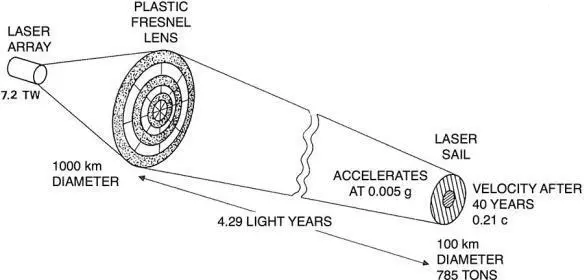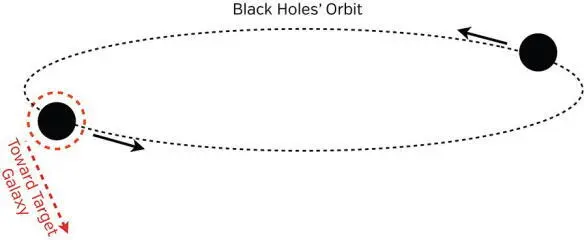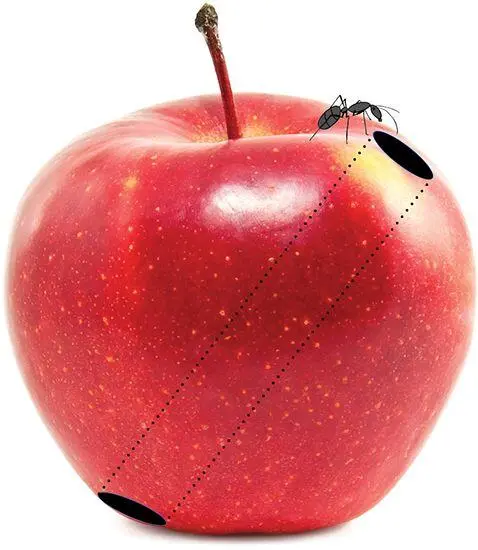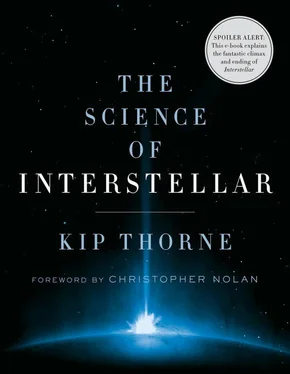
Fig. 13.3. Robert Forward’s laser beam and light sail propulsion system. [From Forward (1984).]
Forward, like Dyson, imagined his scheme practical in the twenty-second century. When I look at the technical challenges, I think longer.
Gravitational Slingshots in a Black-Hole Binary

My third example is my own wild—very wild!—variant of an idea due to Dyson (1963).
Suppose you want to fly across much of the universe (not just interstellar travel, but intergalactic travel) at near light speed in a few years of your own life. You can do so with the aid of two black holes that are orbiting each other, a black-hole binary . They must be in a highly elliptical orbit and must be large enough that their tidal forces do not destroy your ship.
Using chemical or nuclear fuel, you navigate your ship into an orbit that comes close to one of the black holes: a so-called zoom-whirl orbit (Figure 13.4). Your ship zooms close to the hole, whirls around it a few times, and then, when the hole is traveling nearly directly toward its companion, the ship zooms out, crosses over to the companion hole, and slides into a whirl around it. If the two holes are still headed toward each other, the whirl is brief: you zoom back toward the first hole. If the holes are no longer headed toward each other, the whirl is much longer; you must park yourself in orbit around the second hole until the holes are again headed toward each other, and then launch back toward the first hole. In this way, always traveling between holes only when the holes are approaching each other, your ship gets boosted to higher and higher speeds, approaching as close as you wish to the speed of light if the binary is sufficiently elliptical.
It is a remarkable fact that you only need a small amount of rocket fuel to control how long you linger around each hole. The key is to navigate onto the hole’s critical orbit, and there perform your controlled whirl. I discuss the critical orbit in Chapter 27. For now, suffice it to say that this is a highly unstable orbit. It is rather like riding a motorcycle around a very smooth volcano rim. If you balance delicately, you can stay on the rim as long as you want. When you wish to leave, a slight turn of the bike’s front wheel will send you careening off the rim. When you want to leave the critical orbit, a slight rocket thrust will enable centrifugal forces to take over and send your ship careening toward the other black hole.
Once you are as close to the speed of light as you wish, you can launch yourself off a critical orbit toward your target galaxy in the distant universe (Figure 13.5).

Fig. 13.4. Zoom-whirl orbit brings a spacecraft up to near light speed.

Fig. 13.5. Launching off a critical orbit toward a distant galaxy.
The trip may be long; as much as 10 billion light-years’ distance. But when you move at near light speed, your time flows far more slowly than on Earth. If you are close enough to light speed, you can make it to your target in a few years or less, as measured by you—slowing down with the aid of a highly elliptical black-hole binary at your target, if you can find one! See Figure 13.6.
You can return home by the same method. But your homecoming may not be pleasant. Billions of years will have passed at home, while you have aged only a few years. Imagine what you find.
These types of slingshots could provide a means for spreading a civilization across the great reaches of intergalactic space. The principal obstacle (perhaps insurmountable!) is finding, or making, the needed black hole binaries. The launch binary might not be a problem if you are a sufficiently advanced civilization, but the slow-down binary is another matter.
What happens to you if there is no slow-down binary, or there is one, but your aim is bad and you miss it? This is a tricky question because of the expansion of the universe. Think about it.

Fig. 13.6. Slowing down by slingshots in a target black-hole binary.
As exciting as these three far-future propulsion systems may seem, they truly are far future. Using twenty-first-century technology, we are stuck with thousands of years to reach other solar systems. The only hope (an exceedingly faint hope) for faster interstellar travel, in the event of an earthly disaster, is a wormhole like that in Interstellar, or some other extreme form of spacetime warp.
How Wormholes Got Their Name

My mentor, John Wheeler, gave astrophysical wormholes their name. He based it on wormholes in apples (Figure 14.1). For an ant walking on an apple, the apple’s surface is the entire universe. If the apple is threaded by a wormhole, the ant has two ways to get from the top to the bottom: around the outside (through the ant’s universe) or down the wormhole. The wormhole route is shorter; it’s a shortcut from one side of the ant’s universe to the other.

Fig. 14.1. An ant explores a wormhole-endowed apple.
The apple’s delicious interior, through which the wormhole passes, is not part of the ant’s universe. It is a three-dimensional bulk or hyperspace (Chapter 4) . The wormhole’s wall can be thought of as part of the ant’s universe. It has the same dimensionality as the universe (two dimensions) and it joins onto the universe (the apple’s surface) at the wormhole’s entrance. From another viewpoint, the wormhole’s wall is not part of the ant’s universe; it is just a shortcut by which the ant can travel across the bulk, from one point in its universe to another.
Flamm’s Wormhole

In 1916, just one year after Einstein formulated his general relativistic laws of physics, Ludwig Flamm in Vienna discovered a solution of Einstein’s equations that describes a wormhole (though he did not call it that). We now know that Einstein’s equations allow many kinds of wormholes (wormholes with many different shapes and behaviors), but Flamm’s is the only one that is precisely spherical and contains no gravitating matter. When we take an equatorial slice through Flamm’s wormhole, so it and our universe (our brane) have just two dimensions rather than three, and when we then view our universe and the wormhole from the bulk, they look like the left part of Figure 14.2.
With one of our universe’s dimensions lost from the picture, you must think of yourself as a two-dimensional creature confined to move on the bent sheet or on the wormhole’s two-dimensional wall. There are two routes for travel from location A in our universe to location B : the short route (dashed blue curve) down the wormhole’s wall, or the long route (dashed red curve) along the bent sheet, our universe.
Читать дальше



















